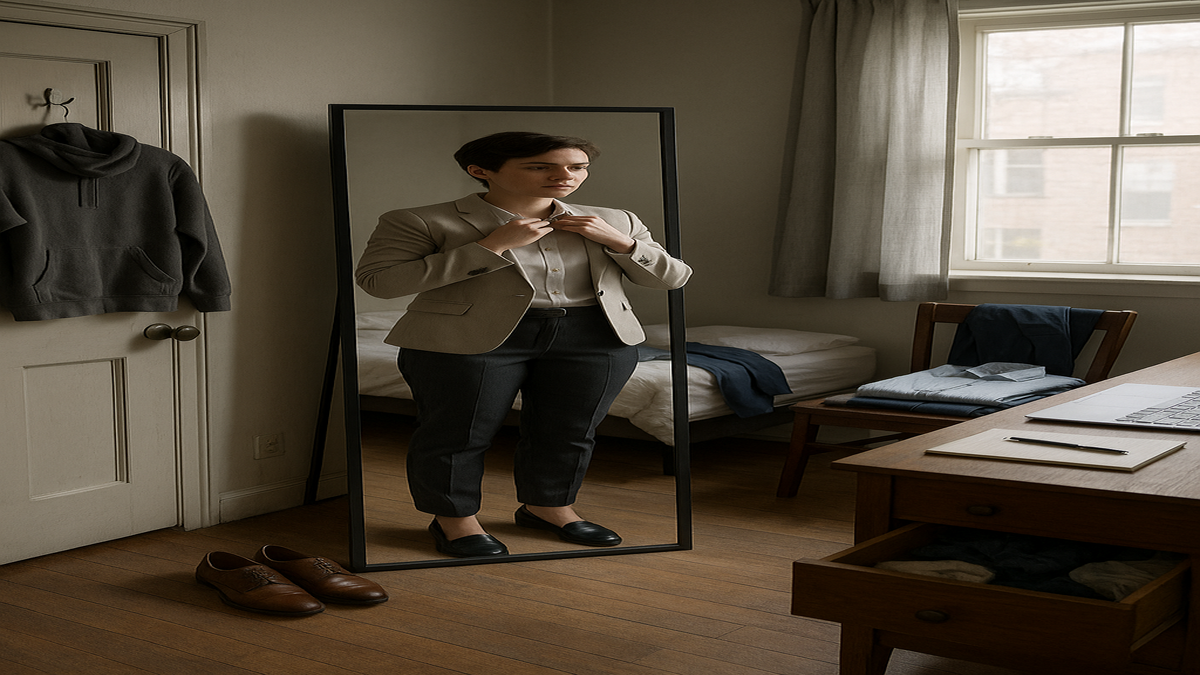If you’ve landed a job interview in 2025, congratulations. But before you even speak a word, your clothing will say a lot. The question is: what, exactly, should it say this year?
The shifting expectations of interview attire
Over the past few years, dress codes across industries have evolved. Suits are no longer a universal default. Still, that doesn’t mean a hoodie and sneakers belong in an interview—unless you’re interviewing at a startup in downtown Austin. I spoke with hiring managers, career advisors, and recruiters who all echoed the same sentiment: context is everything.
“One step up from the daily office look,” is how many now frame the ideal approach. That standard makes more sense than ever, given the range of workplace cultures and the ongoing shift toward hybrid or remote-first environments. According to Indeed (2025), about 74% of employers now classify themselves as ‘business casual,’ leaving formalwear reserved for industries like law, finance, or executive search.
Dress codes by workplace type
The following breakdown presents tried-and-true suggestions based on your interview setting:
| Workplace type | Recommended attire | What to avoid |
|---|---|---|
| Casual | Dark jeans or pressed pants, button-down shirt, neat blouse, knee-length dress, cardigan, clean shoes | Graphic tees, distressed denim, flip-flops |
| Business Casual | Tailored pants or skirt, structured top, blazer or neat jacket, loafers or flats | Oversized logos, bold patterns, excessive accessories |
| Business Formal | Dark suit (navy or charcoal), buttoned shirt, conservative tie if applicable, skirt suit or dress with blazer | Bright colors, short skirts, uncoordinated pieces |
What professionals say
During my reporting, I spoke to Nicole Walters, a corporate recruiter based in Chicago. She’s hired across tech, non-profits, and healthcare. Her take? Familiar, but still timely.
“Start with the company culture and go a notch higher. If it’s a startup, you don’t need a suit—but you do need to look intentional. The biggest mistake is looking like you didn’t think about it. That can read as disinterest.”
Walters emphasized neatness over flash. Shoes polished, no frayed hems, simple accessories. She also pointed to remote interviews, where half-measures show up more than you’d think—”People still wear gym shorts below the Zoom frame. That’s a bad habit. It bleeds into body language.”
Style vs. comfort: Finding the right mix
The prevailing advice from Coursera’s 2025 career guide emphasizes the tightrope balance between comfort and professionalism. Overly tight clothing or uncomfortable shoes can distract both you and the interviewer. Clothing should fit well, allow movement, and align with your body language.
This year, neutral colors—grays, black, navy, or brown—dominate again, although small, textural patterns are making cautious appearances in creative industries. Think a herringbone blazer or subtle check shirt. You should still avoid clashing patterns or loud textures.
Quick checklist: What not to wear
- Strong perfume or cologne—it can overwhelm in close settings, or linger in a bad way.
- Distracting jewelry or noisy accessories—avoid anything that fidgets or clinks.
- Athletic sneakers, sandals, or flip-flops—even in casual offices.
- Clothes with pet hair, visible wrinkles, or missing buttons.
- Messages or slogans—your T-shirt shouldn’t be talking for you.
Industry specifics: How much does it matter?
Yes, the industry matters. A graphic designer and a paralegal shouldn’t dress the same way at an interview. Creative roles often allow for more flexibility—a patterned dress shirt under a blazer at a design firm might land just fine. But in finance, law, or government? Stick to dark suits. Tailoring matters even more there.
Referencing the company’s social media profiles, “About Us” page, or photos from past events can be incredibly informative. Think of this as dress-code reconnaissance.
Final prep steps
The day before the interview, lay out your full look—including shoes and accessories. Try everything on, sit down in it, check mirrors. Set aside backups. Make sure your bag includes a pen, a small notepad, and breath mints (but skip chewing gum).
Don’t forget seasonal adjustments. For winter, a clean coat and formal boots matter. In summer, fabrics like cotton or linen are acceptable—just avoid anything too sheer or wrinkled.
FAQ
How can I tailor my outfit to fit a specific company culture?
Start with the company’s official website and LinkedIn. Look at team photos, videos, or blog posts. Try to match the tone, then step slightly above it. If everyone wears T-shirts, go with a collared shirt. Avoid guessing—when in doubt, opt for business casual.
What are some common mistakes to avoid when choosing interview attire?
Wearing clothing that fits poorly or hasn’t been ironed is a frequent misstep. Other issues: strong fragrances, visible logos, or outfits that are too trendy. Never assume casual means sloppy—it rarely does.
How important is it to match the color of my suit and shoes?
Matching matters visually. Black suit? Black shoe. Brown shoes with navy or gray are acceptable, but stay consistent. Clashing tones stand out more than people think, especially in formal environments.
Should I consider the industry I’m applying to when choosing my outfit?
Absolutely. Creative industries tolerate more expression; finance, healthcare, and law require stricter formality. Understand the norms, and when unsure, dress conservatively—you won’t lose points for professionalism.
Are there any specific accessories that can make a positive impression?
Yes, but keep it subtle. A clean watch, muted earrings, or a sleek notebook all signal care. Avoid flashy belts, dangling jewelry, or novelty items. The goal is to enhance—not distract from—your presence.



